The MSI MEG X570 Godlike Motherboard Review: Thor's Flagship
by Gavin Bonshor on August 28, 2019 12:00 PM EST- Posted in
- Motherboards
- AMD
- MSI
- 10G Ethernet
- Ryzen
- PCIe 4.0
- Ryzen 3000
- X570
- X570 Godlike
- MEG
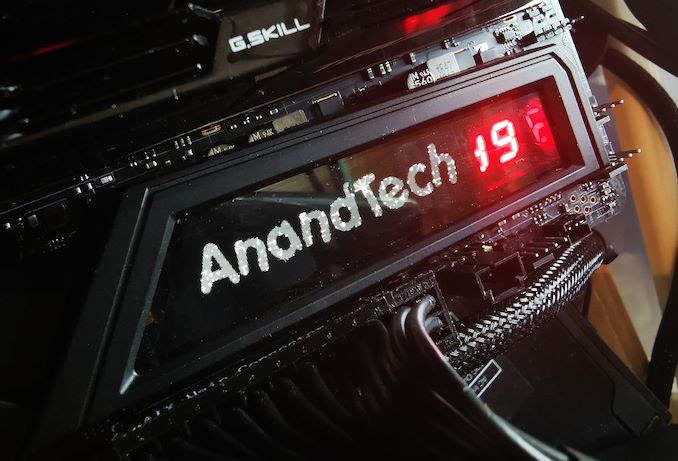
With the introduction of AMD's X570 chipset, motherboard vendors have upped its game in the premium stakes with a variety of premium mid-range and high-end models. The MEG X570 Godlike is MSI's flagship model and is heavily geared towards gamers and enthusiasts. The premium controller set of the X570 Godlike is spearheaded by Killer Networking: with dual on-board ports, Wi-Fi 6 802.11ax connectivity, and a 10 G Super LAN add-on card in the accessories bundle. Also on offer is up to five PCIe 4.0 x4 M.2 slots, two of which come from an Xpander-Z Gen4 add-on card, and a pair of Realtek ALC1220 HD audio codecs which makes this one of the most feature-rich models on the X570 chipset.
Mjolnir for X570
The MEG X570 Godlike is MSI's current flagship in its X570 line-up and represents its enthusiast gaming MEG series. Building on a similar design as the MSI MEG X570 Ace, which we have already reviewed, the X570 Godlike includes plenty of RGB options with an Infinity Mirror 2 on the rear panel cover, as well as RGB LEDs integrated into the actively cooled X570 chipset heatsink. An interesting design aspect is the customizable OLED panel to the right of the four memory slots which allows users to upload their own GIFs and animations.
There are three PCIe 4.0 x4 M.2 slots onboard with three individual M.2 heatshields, while the accessories bundle includes an M.2 Xpander-Z Gen4 PCIe 4.0 addon card which adds an additional two PCIe 4.0 x4 M.2 slots. Also included are six SATA ports with support for RAID 0, 1, and 10 arrays, while the four memory slots have support for DDR4-4800 and a total capacity of up to 128 GB.
As this is a flagship aimed at enthusiasts looking to push the Ryzen 3000 processors to its limits, cooling is important and there are a total of nine 4-pin fan headers featured around the edge of the board which are split into a single header for a CPU fan, one for a water pump, and seven for chassis fans.
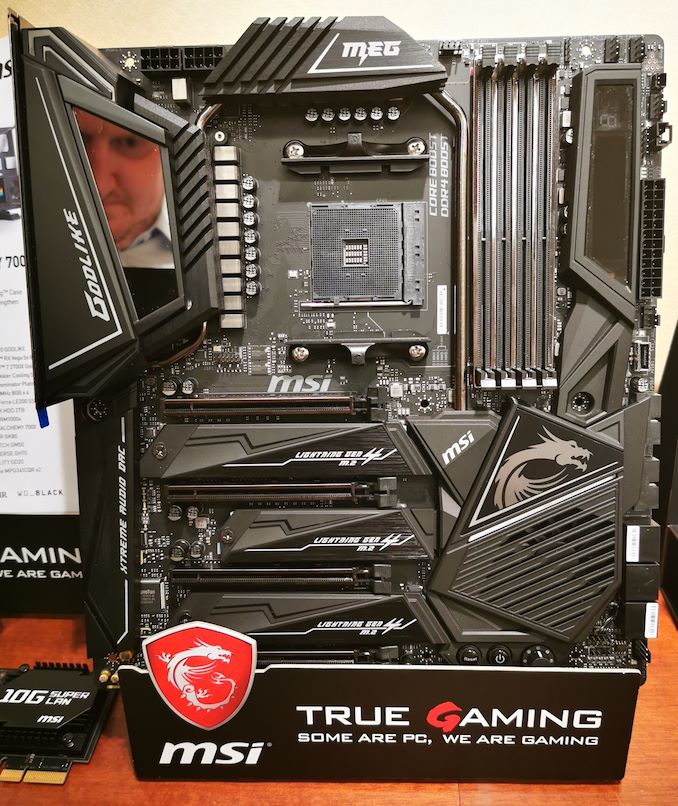
Infinity Mirror means business
Another enthusiast-level feature is a solid 14+4 phase power delivery controlled by an International Rectifier IR35201 PWM controller which operates in a 7+1 configuration. The 14-phase CPU VCore section is running with 7 x IR3599 doublers, while the 4-phase SoC section is running off a single IR3599 which splits the signal into four. This is a very capable setup with its use quality 70 A power stages throughout both sections and has already been tested on sub-zero cooling methods to great effect by some extreme overclockers. Cooling this mammoth power delivery is two large aluminium heatsinks which are interconnected by a heat pipe which also connects it to the X570 chipset heatsink.
On the lower half of the PCB is four full-length PCIe 4.0 slots, three from the CPU. These operate at x16/x0/x0/x4, x8/x0/x8/x4, and x8/x4/x4/x4, such that the fourth full-length slot is locked at PCIe 4.0 x4.
Along the bottom of the PCB is an overclockers toolkit which consists of a reset and power switch, a Game Boost overclocking profile preset dial, a pair of small buttons which allows users to overclock or downclock the base-clock in increments of 1 MHz, while a dual BIOS switch allows users to flick between two different BIOS versions; perhaps one could be set up for extreme overclocking.
MSI has included two Ethernet ports on the rear panel controlled by a Killer E3000 2.5Gbit and Killer E2600 1Gbit NIC pairing. Offering Wireless and BT 5.0 connectivity is a Killer AX1650 Wi-Fi 6 802.11ax wireless interface. Also included in the accessories bundle is an Aquantia AQC107 10 G Super Lan PCIe add-on card. Also included on the rear panel is USB 3.1 G2 connectivity with three G2 Type-A and a single Type-C G2 port, with a further two USB 3.1 G1 Type-A ports. MSI has also kitted out the MEG X570 Godlike with an impressive onboard audio solution with two Realtek ALC1220 HD audio codecs, one for the rear panel connectors, and one for the front panel. Another inclusion is an ESS 9018 Sabre DAC which powers the 6.3 mm headphone port on the rear panel. There's also a front-panel USB 3.1 G2 Type-C header, with two USB 2.0 headers which provide a total of four ports.
MSI MEG X570 Godlike Block Diagram
As expected from the number of premium controllers, the larger E-ATX form factor, and the OLED display, the MSI MEG X570 Godlike currently has the highest power draw of all the AM4 boards tested with the Ryzen 7 3700X processor so far. With both the MSI X570 Godlike and X570 Ace contending for the highest power draw, the X570 Godlike pulls over 13 W more in an idle state, and 11 W in a long idle power state. The MSI MEG X570 Godlike also has the longest POST time out of the X570 models test so far too with a default POST time of 33.9 second. In our CPU and gaming tests however, the MSI MEG X570 Godlike performed brilliantly featuring at the top of the charts across most benchmarks, albeit very marginally.
Early revisions of MSI's firmware on X570 hasn't been favorable for users looking to use the Game Boost profiles with some very questionable setting configurations; mainly too much CPU VCore which in turn, increases the heat output to dangerous levels. We have spoken to MSI and this is something they intend to fix with its next firmware update. When manually overclocking, we managed to squeeze out 4.3 GHz with a CPU VCore of 1.375; this is the brick wall for our Ryzen 7 3700X chip, and the MSI MEG X570 Godlike managed this comfortably. The performance in POV-Ray wasn't throttled as we went up each 100 MHz frequency step, and it should be noted that when overclocking on MSI's X570 models, performance isn't throttled after a certain temperature; instead, the system will shut down once CPU temperatures rise to 110ºC
The MSI MEG X570 Godlike as its name would suggest is the premier model in its line-up and as a result, is feature-laden. From its triple Killer Networking controller set, a triple-header of audio controllers, the scope for up to five PCIe 4.0 x4 M.2 slots (three onboard, two add-on), and a solid-looking 14+4 phase power delivery, the Godlike looks to be one the most comprehensive X570 motherboards on the market. Its main competition comes from the GIGABYTE X570 Aorus Xtreme ($700) and the ASUS ROG Crosshair VIII Formula ($700); both of those models also come with unique features, but the MSI MEG X570 Godlike ($700) does have four full-length PCIe 4.0 slots, capability for up to five PCIe 4.0 x4 M.2 drives out of the box, and also has plenty to offer users in aesthetics with the Mystic Light Infinity Mirror 2, and the customizable OLED panel.


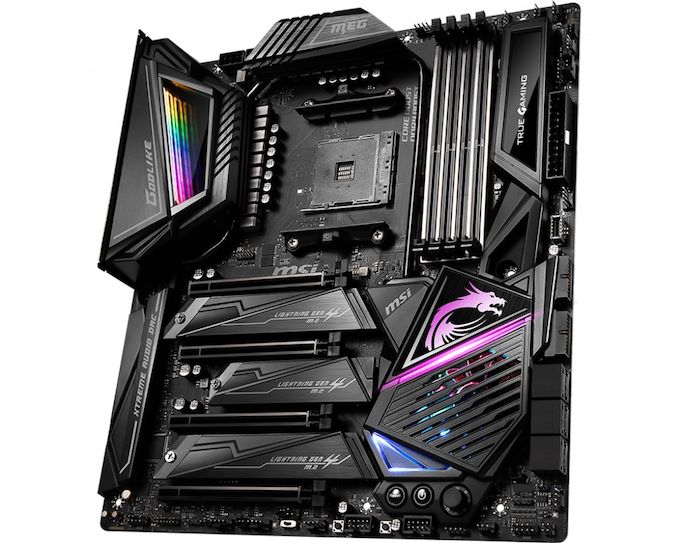



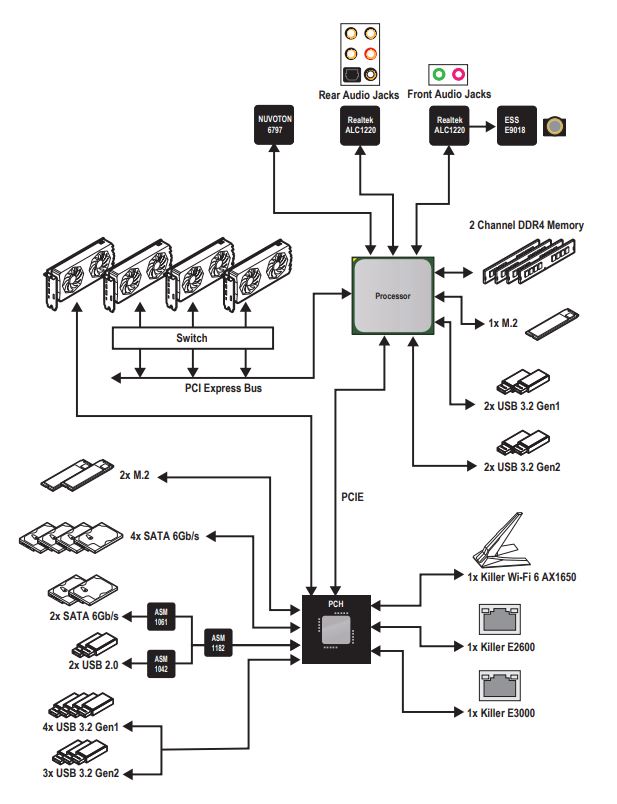
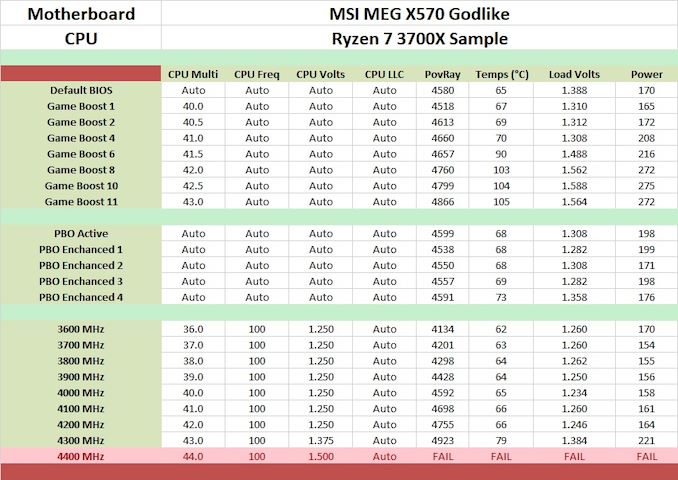








116 Comments
View All Comments
oynaz - Saturday, August 31, 2019 - link
I actually prefer more cores to faster cores in my DAW. Each effect bus, or track, cannot be split into multiple cores, true, but you usually quite a few buses going.inighthawki - Friday, August 30, 2019 - link
GamingSweetbabyjays - Thursday, August 29, 2019 - link
In a professional setting, where you are doing thread intensive workloads, and IT is not cool with you overclocking...then yes, I totally agree 3900x makes way more sense."use less power overall" ? 9900k has a TDP of 95W, while the 3900x has a TDP of 105W, Additionally the Z390 chipset has a TDP of 6W while the X570 has a TDP of 11W. Now I know there is a discrepancy between how AMD and Intel measure TDP, so the numbers at face value may not be telling the whole story. That said, I would be very interested to see overall system power draw for both to test the veracity of your statement.
AshlayW - Thursday, August 29, 2019 - link
Oh boy, you actually think the 9900K uses 95W? Joke's on you pal, that's at 3.6 GHz. At full turbo clocks the 9900K uses 150-200W. Ryzen 3000 is almost twice the performance per watt in some scenarios.Trikkiedikkie - Saturday, August 31, 2019 - link
With the 3900 having many things inside the processor, whereas the 9900 has extra chips needed. And Intel's numbers only count for baseclockSweetbabyjays - Thursday, August 29, 2019 - link
"trounce it with it's higher core-count parts in multi-threaded scenarios." Aside from some synthetic benchmarks, I suggest looking at the puget systems website for professional benchmarks, if you're looking for more real world professional performance scenarios.The 12 core part is better in some(in some the 9900k is better) scenarios, but rarely(if ever) by more than 10%. Perhaps your definition of "trounce" is different from mine thought.
If you're gaming much more often than you are working/creating the increased core count really wont improve your overall computing experience, if at all.
Oliseo - Thursday, August 29, 2019 - link
This is true. But the argument remains, just how many people actually use highly mutli-threaded scenarios.I'd wager if you got a venn diagram of gamers and content creators, the content creators would simply be a small spot on the very large gaming circle.
I know a lot of gamers, yet I struggle to meet 3D cad designers or Film Editors.
So yes, you're right, AMD will trounce Intel in that respect. But until we get games using more than 8 cores, the majority of people will not be better off because they simply don't need those extra cores as they don't run any software that can make use of them.
And that goes for AMD folks wanting to get the AMD chips as well.
Trikkiedikkie - Saturday, August 31, 2019 - link
Gaming is soo small compared to people doing actual work.AshlayW - Thursday, August 29, 2019 - link
$150 more, for 10% higher single core performance when both CPUs already have extremely good single core performance, and you can place a 4700X in the same motherboard next year that will have even higher single core than the 9900K? Seriously people, consumer stupidity is why Intel is still selling CPUs.Trikkiedikkie - Saturday, August 31, 2019 - link
Single core is soooo last century.Only people that have very little serious work apart from Adobe want that.